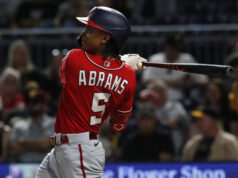The art of closing baseball games is not without its scrutiny, allure and fame. We take a look at the evolution of the MLB closer.
By William Chase
 The role of baseball’s closer is perhaps the most exciting, thrilling, agonizing, and most nauseating scenario in sports.
The role of baseball’s closer is perhaps the most exciting, thrilling, agonizing, and most nauseating scenario in sports.
Three outs to go. You’re up. All eyes on you.
In baseball, the game either ends in triumph or success. Only the good closers have been able to survive this role amid scrutiny from either the fans, media, and all Monday-morning quarterbacks.
The great ones could sustain it. Mariano Rivera, Trevor Hoffman and Dennis Eckersley all come to mind. There’s many, many more.
Hall of Famers in the public’s eye—I think most would agree about Hoffman.
The man with the second-most saves ever accomplished everything Rivera did. The glaring omission is playoff performance; Hoffman only has 13 career postseason innings. Rivera has 42 career postseason saves in 141.0 innings, the all-time record for lowest postseason ERA (0.70).
@THoffman51 makes strong debut on #HOF ballot: https://t.co/Kp8PtCAQFo pic.twitter.com/uKG9jiM2fm
— MLB (@MLB) January 7, 2016
You can’t hold lack of postseason success—opportunity—over Hoff’s head. The San Diego Padres are not, and were not, the New York Yankees. Who knows how Hoffman could have further taken his legacy, if given the same incredible luck of being blessed with deep and great rosters.
Alas, he will have his day.
Lee Arthur Smith, who was baseball’s all-time saves leader with 475 until Hoff and Mo caught up and ultimately surpassed him, is not in the Hall of Fame.
Why not?
Whether pitchers such as Smith are considered Hall of Fame-worthy or not, depends on whatever the variable and who you ask.
The purpose here isn’t to explain why Smith is worthy of the Hall. His job was to get three outs, and though he may not have been exceptionally dominant, did his job about as well as anyone.
Three outs more often than not, right?
One can debate the value of the actual save stat. Eric Gagné had arguably the most successful 3-year stint a closer can have, the owner of the Major League record, 84-consecutive saves.
Gagné’s dominance as a closer was short-lived, as he was a fairly marginal pitcher before and after that 2002-2004 stretch.
Francisco Rodriguez holds the single-season record for most saves with 62 in 2008. Eight of those saves came by way of less than a full inning, and he did not pitch more than one inning in any game that season, postseason excluded.
Between 2005, when Rodriguez was officially tabbed the closer for the Los Angeles Angels, and 2010, K-Rod only had 14 multiple-inning saves.
Of course, the game has evolved from the days of such closing scenarios. The expansion of rosters, pitch count limits, added bullpen assets, and various strategies that managers have at their disposal can’t be held against the athlete.
It’s hard to be a closer, and no, I don’t have to be one to understand that. Still, the reality is, outside of Mo and Hoffman, the average lifespan of the role, especially from the great ones to the good ones, has diminished.
SI’s Cliff Corcoran paints that picture:
“Rivera’s 16 seasons with 20 or more saves is a major league record, as are his 15 seasons with 30 saves, his nine seasons with 40 (tied with Hoffman), and his two seasons with 50 saves (tied with Eric Gagné). In total, 157 pitchers other than Rivera have seasons of at least 20 saves since 1997 and 69 of them only got that many once.”
Farewell @marianorivera…the greatest of all time. See you in the Hall of Fame. @redsox @yankees
— Dennis Eckersley (@Eck43) September 13, 2013
Rivera and Hoffman were two closers who played the game just under 20 years—Rivera retired in 2013 having played 19 seasons; Hoffman retired in 2010 after 18 years. Mo became the full-time closer two years into his 19 year career, and Hoffman became the closer in 1994, after being forced to reinvent himself following injury.
Originally drafted as a shortstop out of college adds to the allure that is Hoffman.
What Rivera and Hoffman were able to do may never be duplicated. Lots of closers have had nice careers in closing games, but the extent to which past greats were able to amass the career numbers they did will likely never be reached.
After Rivera and Hoffman, names such as Joe Nathan and Jonathan Papelbon surface as closers who found, and sustained, long-term success.
Nathan, a prominent figure on those great Minnesota Twins’ clubs in the mid 2000s, as well as stints in Texas and Detroit, spent parts of 15 seasons in the bigs. He had nine seasons in which he amassed at least 30 saves and at least 50 appearances in a season.
Papelbon has basically been a closer his entire career, with the exception of his rookie-year in 2005. Having spent at least 10 years in the same role, he has saved nearly 350 games.
Huston Street has accumulated 315 saves since 2005. Craig Kimbrel (225 saves) is a closer who has been in the same role for five seasons now. But who else even comes close?
Mark Melancon was the top closer in 2015 with 51 saves, and has 121 between 2011-2015. Trevor Rosenthal had the second-most saves in 2015 with 48, and had 45 the year prior, but that’s the extent for Rosenthal at this juncture.
Of course the closer position was largely defined by the likes of Bruce Sutter, Rich “Goose” Gossage and Eckersley, all Hall of Famers, all with at least 300 career saves. Eck pitched nearly a quarter-century, having also made a successful career out of starting, before turning to close. Much like John Smoltz would later do.
Goose also pitched over 20 seasons. Sutter pitched just 12 seasons. However they also pitched the now-practically extinct multiple-inning save more often than not.
Rollie Fingers, Goose, Sutter all have at least 188 multiple-inning saves. Rivera, for comparisons sake, has 119 of such saves. People can debate the “quality” of saves, or whether or not Rivera wouldn’t have had 652 saves back in Gooses’ day. Likely not. Bullpens, pitch counts, by-the-book managing being what it is now, it’s still impressive that Rivera has as many 4-out saves, and then some, especially as Corcoran points out, Keith Foulke, the runner-up, had 55 such saves since 1996.
Rivera however, has the MLB record with 31 postseason saves spanning more than one inning. He has the record of 14, six-out saves. Goose is second with seven multi-inning saves, and six, six-out saves.
No matter how you dice it, these aforementioned closers are a collection of some of the best the game has seen. Whether based on career longevity or postseason-combined success, or even for a short stretch. Maybe Rivera wouldn’t have 652 saves in 1975. And maybe Hoffman doesn’t have Rivera’s sparkling postseason ERA.
Craig Kimbrel might end up in the Hall of Fame one day. Maybe 450 becomes the new 600.
The common element many of these pitchers, both past-greats and perhaps future Hall-of-Famers, do have in common is they left their imprint on the game. A Hall of Famer leaves their imprint on their sport.













